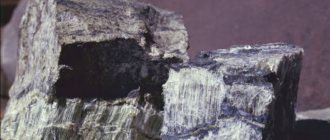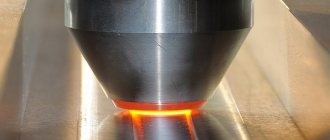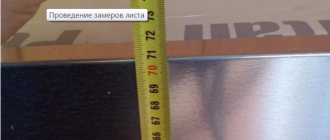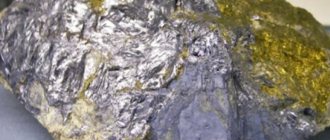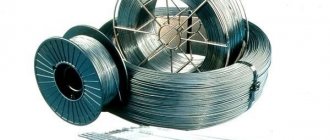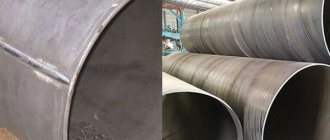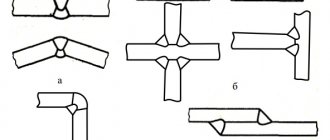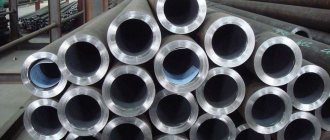Aluminum is a metal coated with a matte silver oxide film, the properties of which determine its popularity: softness, lightness, ductility, high strength, corrosion resistance, electrical conductivity and lack of toxicity. In modern high technologies, the use of aluminum is given a leading place as a structural, multifunctional material.
The greatest value for industry as a source of aluminum is natural raw materials - aluminum ore , a component of rock in the form of bauxite, alunite and nepheline.
The industrial scale of the “winged” metal began only in the 20th century. Today, it is one of the sought-after materials in various industries from electronics to the space and aviation industries.
Aluminum ore was first obtained in the form of a silvery metal in 1825 in a volume of just a few milligrams, and before the advent of mass production, this metal was more expensive than gold.
For example, one of the royal crowns of Sweden contained aluminum, and D. I. Mendeleev in 1889 received an expensive gift from the British - scales made of gold and aluminum.
What raw materials are needed to produce aluminum ore? How is one of the most essential materials of our time produced?
Bauxite ore is the basis of global aluminum production
The silver metal itself is directly obtained from alumina.
This raw material is aluminum oxide (Al2O3), obtained from ores:
- Bauxite;
- Alunitov;
- Nepheline syenites.
The most common source of starting material is bauxite, which is considered the main aluminum ore.
Despite the more than 130-year history of discovery, it has still not been possible to understand the origin of aluminum ore. It is possible that simply in each region the raw materials were formed under the influence of certain conditions. And this makes it difficult to derive one universal theory about the formation of bauxite.
There are three main hypotheses about the origin of aluminum raw materials:
- They were formed due to the dissolution of certain types of limestone as a residual product.
- Bauxite was obtained as a result of weathering of ancient rocks with their further transport and deposition.
- The ore is the result of chemical processes of decomposition of iron, aluminum and titanium salts, and fell as sediment.
However, alunite and nepheline ores were formed under different conditions from bauxite. The former were formed under conditions of active hydrothermal and volcanic activity. The second - at high temperatures of magma.
As a result, alunites generally have a crumbly porous structure. They contain up to 40% of various aluminum oxide compounds. But, in addition to the aluminum-bearing ore itself, the deposits, as a rule, contain additives, which affects the profitability of their mining. It is considered profitable to develop a deposit with a 50 percent ratio of alunites to additives.
Nephelines are usually represented by crystalline samples, which, in addition to aluminum oxide, contain additives in the form of various impurities. Depending on the composition, this type of ore is classified into types. The richest contain up to 90% nephelines, second-rate 40-50%; if the minerals are poorer than these indicators, then it is not considered necessary to develop them.
Having an idea of the origin of minerals, geological exploration can quite accurately determine the location of aluminum ore deposits. Also, the formation conditions, which influence the composition and structure of minerals, determine the extraction methods. If the deposit is considered profitable, its development is established.
Nepheline
This is an aluminum ore of igneous origin. It is a fully crystalline alkaline rock. Depending on the composition and technological features of processing, several grades of nepheline ore are distinguished:
- first grade – 60–90% nepheline; it contains more than 25% alumina; processing is carried out by sintering;
- second grade – 40–60% nepheline, the amount of alumina is slightly lower – 22–25%; enrichment is required during processing;
- the third grade is nepheline minerals, which are of no industrial value.
Properties of aluminum ore
Bauxite is a complex compound of oxides of aluminum, iron and silicon (in the form of various quartz), titanium, as well as with a small admixture of sodium, zirconium, chromium, phosphorus and others.
The most important property in aluminum production is the “breakability” of bauxite. That is, how easy it will be to separate unnecessary silicon additives from it in order to obtain the feedstock for metal smelting.
Natural deposits of bauxite, nepheline, alunite, clay, and kaolin can serve as a source of raw materials. Bauxite is the most saturated with aluminum compounds. Clays and kaolins are the most common rocks with a significant alumina content. Deposits of these minerals are found on the surface of the earth.
Aluminum ore in nature exists only in the form of a binary compound of metal with oxygen. This compound is extracted from natural mining ores in the form of bauxite, consisting of oxides of several chemical elements: aluminum, potassium, sodium, magnesium, iron, titanium, silicon, phosphorus.
The basis for producing aluminum is alumina. To form it, the ore is ground into a fine powder and heated with steam, separating most of the silicon. And this mass will become the raw material for smelting.
To obtain 1 ton of aluminum, you will need about 4-5 tons of bauxite, from which, after processing, about 2 tons of alumina are formed, and only then you can get the metal.
Features of mineral resources of the Scandinavian Peninsula
European countries were the earliest to begin large-scale environmental impacts. The Scandinavian Peninsula is an exception. The region's crustal resources remained untapped until the second half of the 20th century. The small population of Scandinavia also played a role in preserving the region's mineral resources.
Zinc and copper are the main elements that are used in almost all European countries. The supply of European countries with this type of raw material is covered by imports.
Technology for the development of aluminum deposits. Aluminum ore mining methods
When the depth of occurrence of aluminum-bearing rocks is insignificant, they are mined using open-pit mining. But the process of cutting off ore layers will depend on its type and structure.
- Crystalline minerals (usually bauxite or nepheline) are removed by milling. Mineral miners are used for this purpose. Depending on the model, such a machine can cut a layer up to 600 mm thick. The rock thickness is developed gradually, forming shelves after passing through one layer.
This is done to ensure the safe position of the operator’s cabin and running gear, which in the event of an unexpected collapse will be at a safe distance.
- Loose aluminum-bearing rocks preclude the use of milling. Since their viscosity clogs the cutting part of the machine. Most often, these types of rocks can be cut using mining excavators, which immediately load the ore onto dump trucks for further transportation.
Transporting raw materials is a separate part of the entire process. Usually, whenever possible, enrichment plants try to be built near mining sites. This allows the use of belt conveyors to supply ore for processing. But, more often, confiscated raw materials are transported by dump trucks. The next stage is the enrichment and preparation of rock to obtain alumina.
- The ore is moved using a belt conveyor to the raw material preparation workshop, where a number of crushing devices can be used, crushing the minerals one by one to a fraction of approximately 110 mm.
- The second section of the preparatory workshop supplies prepared ore and additional additives for further processing.
- The next stage of preparation is sintering the rock in furnaces.
Also at this stage, it is possible to process raw materials by leaching with strong alkalis. The result is a liquid aluminate solution (hydrometallurgical processing).
- The aluminate solution goes through a decomposition stage. At this stage, an aluminate pulp is obtained, which in turn is sent for separation and evaporation of the liquid component.
- After which this mass is cleaned of unnecessary alkalis and sent for calcination in ovens. As a result of this chain, dry alumina is formed, which is necessary for the production of aluminum by hydrolysis treatment.
The complex technological process requires large amounts of fuel and limestone, as well as electricity. This is the main factor in the location of aluminum smelters - near a good transport interchange, and the presence of nearby deposits of the necessary resources.
However, there is also a mining method of extraction, when rock is cut out from the layers according to the principle of coal mining. After which the ore is sent to similar plants for enrichment and aluminum extraction.
One of the deepest “aluminum” adits is located in the Urals in Russia, its depth reaches 1550 meters!
Content
- Mineral resources of foreign Europe in the context of industrialization of the region
- Provision of foreign European countries with mineral resources
- Table of mineral resources of Foreign Europe
- Features of mineral resources of the Scandinavian Peninsula
- What have we learned?
- Population of Italy
- Cities of Italy
- Italy
- Foreign Europe
- Foreign Europe - countries and capitals
- Foreign European countries with access to the sea
- Subregions of Overseas Europe
- Population of Overseas Europe
- Industries of Foreign Europe
- General characteristics of Foreign Europe
- Overseas Europe Square
- Agglomerations of Foreign Europe
- Monarchical countries of Foreign Europe
- Large countries of Foreign Europe
- Regions of Overseas Europe
- Economic and geographical position of Foreign Europe
- Forms of government of foreign European countries
- Minerals of Foreign Europe
- Peoples of Foreign Europe
- Countries of Foreign Europe with a federal structure
- National composition of Foreign Europe
- Agriculture of Foreign Europe
- Business card of the countries of Foreign Europe
- Population density of Overseas Europe
- Sea ports of Foreign Europe
- Reproduction of the population of foreign Europe
- Transport of Foreign Europe
- Urbanization of Foreign Europe
- Microstates of Foreign Europe
- Tourism of Foreign Europe
- Millionaire cities of foreign Europe
- Hot spots of foreign Europe
- Rivers of Foreign Europe
- Mechanical Engineering of Foreign Europe
- Language families of Foreign Europe
- Religions of Foreign Europe
- Islands and peninsulas of Foreign Europe
- Developed countries of Foreign Europe Mineral resources of Foreign Europe
- UK population
- UK composition
- UK economy
- UK Natural Resources
- France
- Population of France
- Cities of France
- French Parliament
- Geographical location of France
- Agriculture in France
show all
Due to popular demand, you can now: save all your results, receive points and participate in the overall ranking.
- 1. Danil Lysogorsky 504
- 2. Parlefiano Fuello 301
- 3. Anastasia Paranina 228
- 4. Ksyu Pashnina 143
- 5. Anton Ogurtsov 125
- 6. Maria Korneeva 123
- 7. Igor Proskurenko 121
- 8. Valery Rubtsov 104
- 9. No-Name No-Family 100
- 10. Alina Saibel 84
- 1. Maria Nikolaevna 13,550
- 2. Larisa Samodurova 12,820
- 3. Liza 12,355
- 4. Kristina Volosocheva 11,720
- 5. TorkMen 11,551
- 6. Ekaterina 11,386
- 7. Yulia Bronnikova 11,260
- 8. Vlad Lubenkov 11,225
- 9. Fox 11,070
- 10. Vyacheslav 10,940
The most active participants of the week:
- 1. Victoria Neumann - bookstore gift card for 500 rubles.
- 2. Bulat Sadykov - bookstore gift card for 500 rubles.
- 3. Daria Volkova - bookstore gift card for 500 rubles.
Three lucky people who passed at least 1 test:
- 1. Natalya Starostina - bookstore gift card for 500 rubles.
- 2. Nikolay Z - bookstore gift card for 500 rubles.
- 3. David Melnikov - bookstore gift card for 500 rubles.
The cards are electronic (code), they will be sent in the coming days via VKontakte message or email.
Leading countries in aluminum ore production
The main deposits of aluminum are concentrated in regions with a tropical climate, and most of the 73% of deposits are found in just 5 countries: Guinea, Brazil, Jamaica, Australia and India. Of these, Guinea has the richest reserves, more than 5 billion tons (28% of the world share).
If we divide reserves and production volumes, we can get the following picture:
- 1st place – Africa (Guinea).
- 2nd place - America.
- 3rd place – Asia.
- 4th place – Australia.
- 5th – Europe.
The top five countries in aluminum ore production are presented in the table
| A country | Production volumes million tons |
| China | 86,5 |
| Australia | 81,7 |
| Brazil | 30,7 |
| Guinea | 19,7 |
| India | 14,9 |
Also, the main producers of aluminum ores include: Jamaica (9.7 million tons), Russia (6.6), Kazakhstan (4.2), Guyana (1.6).
Mineral resources of foreign Europe in the context of industrialization of the region
The reserves of mineral resources in Foreign Europe, although varied, are small. The distribution of these resources between the northern and southern parts of Europe is uneven. There are ore deposits in the area of the Hercynian fold of the Baltic Shield in the northern part of Europe. The southern part of Europe is rich in igneous minerals and bauxite.
The increased industrialization of the last two centuries has led to a significant depletion of the mineral reserves of overseas Europe.
Rice. 1 Zones of increased industrialization of foreign Europe
Development of aluminum ore deposits in Russia
In our country there are several rich deposits of aluminum ores, concentrated in the Urals and in the Leningrad region. But the main method of extracting bauxite in our country is the more labor-intensive closed mine method, which extracts about 80% of the total mass of ores in Russia.
The leaders in deposit development are the joint-stock company Sevuralboxitrude, JSC Baksitogorsk Alumina, and the South Ural Bauxite Mines. However, their reserves are running out. As a result, Russia has to import about 3 million tons of alumina per year.
| Field | Reserves |
| Little Red Riding Hood (Ural) | For 19 years of production |
| Gornostayskoye and Gornostaysko-Krasnooktyabrskoye | For 18 years of production |
| Blinovo-Kamenskoye | 10 years |
| Kurgazskoe | 10 years |
| Radynsky quarry | 7 years |
In total, 44 deposits of various aluminum ores (bauxite, nepheline) have been explored in the country, which, according to estimates, should be enough for 240 years, with such mining intensity as today.
The import of alumina is due to the low quality of the ore in the deposits, for example, bauxite with a 50% alumina composition is mined at the Red Cap deposit, while in Italy rock with 64% aluminum oxide is extracted, and in China 61%.
Shipbuilding
Aluminum and its alloys are increasingly used in shipbuilding. Aluminum alloys are used to make ship hulls, deck superstructures, communications and various types of ship equipment.
The main advantage of introducing aluminum and its alloys compared to steel is the reduction in the weight of ships, which can reach 50–60%. As a result, it becomes possible to increase the vessel’s carrying capacity or improve its tactical and technical characteristics (maneuverability, speed, etc.).
The most widely used aluminum alloys for the manufacture of river and sea fleet structures are the magnesium alloys AMgZ, AMg5, AMg61, as well as the alloys AMts and D16. The hull of a high-capacity vessel is made of steel, while the superstructure and other auxiliary equipment are made of aluminum alloys. Fishing longboats are manufactured from AMg5 alloy (sheathing).
Weldable alloys of the 5xxx and 6xxx series are widely used in US shipbuilding. Where high strength (500 MPa) is required, semi-finished products from alloys of the 2xxx and 7xxx series are used.
Applications of Aluminum Ore
Basically, up to 60% of ore raw materials are used to produce aluminum. However, the rich composition makes it possible to extract from it other chemical elements: titanium, chromium, vanadium and other non-ferrous metals, which are necessary primarily as alloying additives to improve the quality of steel.
As mentioned above, the technological chain for producing aluminum necessarily passes through the stage of formation of alumina, which is also used as fluxes in ferrous metallurgy.
The rich composition of elements in aluminum ore is also used to produce mineral paint. Also, the smelting method produces alumina cement - a quickly hardening, strong mass.
Another material obtained from bauxite is electrocorundum. It is obtained by smelting ore in electric furnaces. It is a very hard substance, second only to diamond, making it popular as an abrasive.
Also, in the process of obtaining pure metal, waste is formed - red mud. The element scandium is extracted from it, which is used in the production of aluminum-scandium alloys, which are in demand in the automotive industry, rocket science, production of electric drives, and sports equipment.
Provision of foreign European countries with mineral resources
Metal ore deposits in Western Europe are unevenly distributed. The Balkans, Kirun (Sweden) and French Lorraine are iron ore mining regions.
Copper, nickel and chromium are predominantly found in Finland and Sweden.
Hungary and Greece are famous for their bauxite - ores of non-ferrous metals.
Rice. 2 Ore mining
Uranium and titanium have their largest deposits in France and Norway.
The richest copper deposits are in Poland.
The Balkan Peninsula, Scandinavia and Spain concentrated deposits of mercury, tin and polymetals.
Northern Europe is rich in bauxite, which is used to produce aluminum. Minerals of Northern Europe are mainly represented by metals, copper and iron ores.
In the south of Europe, in Italy, deposits of zinc and mercury ores are concentrated.
Bosnia and Herzegovina is rich in iron and aluminum ores.
Nickel ore mining is actively carried out in Germany.
Mining of small gold deposits has been discovered in the UK.
The Baltic countries are not known for their rich mineral resources.
Copper and zinc are found in Serbia, as well as gold and silver in small quantities.
Rice. 3. Map of the provision of foreign European countries with mineral resources
The variety of mineral resources of Foreign Europe is great, but the quantity is insignificant. The growth of the region's industry strictly dictates the needs for this type of raw material.
